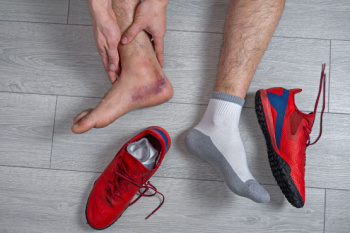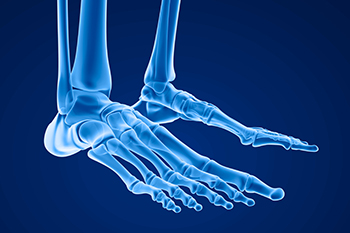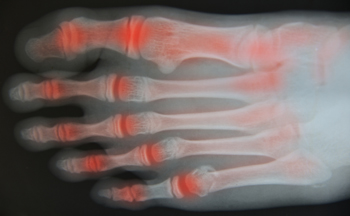Connect With Us
Blog
Items filtered by date: April 2024
Causes of Ankle Sprains

An ankle sprain is caused by damage to the ligaments surrounding the ankle joint, typically resulting from sudden twisting or rolling movements. Ligaments are strong bands of tissue that connect bones and provide stability to joints. When excessive force is applied to the ankle beyond its normal range of motion, the ligaments can stretch or tear, leading to a sprain. This injury often occurs during activities such as running, jumping, or walking on uneven surfaces. Factors contributing to ankle sprains include inadequate warm-up or stretching before physical activity, inappropriate footwear for the activity, and previous ankle injuries that weaken the ligaments. Additionally, individuals with poor balance, weak muscles, or underlying foot or ankle conditions may be more susceptible to sprains. Recognizing the signs of an ankle sprain, such as pain, swelling, bruising, and difficulty bearing weight, is essential for a prompt recovery. If you have endured an ankle sprain, it is suggested that you visit a podiatrist who can accurately diagnose and treat this injury.
Ankle sprains are common but need immediate attention. If you need your feet checked, contact Paul Hutchison, DPM from Hutchison Foot Clinic. Our doctor can provide the care you need to keep you pain-free and on your feet.
How Does an Ankle Sprain Occur?
Ankle sprains take place when the ligaments in your ankle are torn or stretched beyond their limits. There are multiple ways that the ankle can become injured, including twisting or rolling over onto your ankle, putting undue stress on it, or causing trauma to the ankle itself.
What Are the Symptoms?
- Mild to moderate bruising
- Limited mobility
- Swelling
- Discoloration of the skin (depending on severity)
Preventing a Sprain
- Wearing appropriate shoes for the occasion
- Stretching before exercises and sports
- Knowing your limits
Treatment of a Sprain
Treatment of a sprain depends on the severity. Many times, people are told to rest and remain off their feet completely, while others are given an air cast. If the sprain is very severe, surgery may be required.
If you have suffered an ankle sprain previously, you may want to consider additional support such as a brace and regular exercises to strengthen the ankle.
If you have any questions please feel free to contact our office located in Memphis, TN . We offer the newest diagnostic and treatment technologies for all your foot and ankle needs.
Let the Expert Treat Your Ingrown Toenails
How Athletes Cope With Foot Stress Fractures

Athletes face a unique challenge when dealing with foot stress fractures, as these injuries can significantly impact their performance and training routines. The journey to recovery often requires patience, diligence, and a strategic approach. Athletes must prioritize rest and allow ample time for the fracture to heal, refraining from activities that aggravate the injury. Cross-training activities that minimize the impact on the feet, such as swimming or cycling, can help maintain cardiovascular fitness while reducing stress on the injured foot. Additionally, adhering to a balanced diet rich in calcium and vitamin D promotes bone strength and aids in the healing process. Collaborating closely with podiatrists ensures personalized treatment plans tailored to the athlete's specific needs. If you have endured a foot stress fracture from participating in sporting activities or from an injury, it is suggested that you consult a podiatrist who can help you manage this condition.
Stress fractures occur when there is a tiny crack within a bone. To learn more, contact Paul Hutchison, DPM from Hutchison Foot Clinic. Our doctor can provide the care you need to keep you pain free and on your feet.
How Are They Caused?
Stress fractures are the result of repetitive force being placed on the bone. Since the lower leg and feet often carry most of the body’s weight, stress fractures are likely to occur in these areas. If you rush into a new exercise, you are more likely to develop a stress fracture since you are starting too much, too soon. Pain resulting from stress fractures may go unnoticed at first, however it may start to worsen over time.
Risk Factors
- Gender – They are more commonly found in women compared to men.
- Foot Problems – People with unusual arches in their feet are more likely to develop stress fractures.
- Certain Sports – Dancers, gymnasts, tennis players, runners, and basketball players are more likely to develop stress fractures.
- Lack of Nutrients – A lack of vitamin D and calcium may weaken the bones and make you more prone to stress fractures
- Weak Bones – Osteoporosis can weaken the bones therefore resulting in stress fractures
Stress fractures do not always heal properly, so it is important that you seek help from a podiatrist if you suspect you may have one. Ignoring your stress fracture may cause it to worsen, and you may develop chronic pain as well as additional fractures.
If you have any questions, please feel free to contact our office located in Memphis, TN . We offer the newest diagnostic and treatment technologies for all your foot care needs.
Common Foot and Ankle Injuries in Golf

Playing golf, a sport known for its leisurely pace and precision, can unexpectedly subject players to a range of foot and ankle injuries. Among the most prevalent is plantar fasciitis, a condition characterized by inflammation of the plantar fascia due to repetitive stress on the foot during swings and walks across uneven terrain. Additionally, ankle sprains often occur from missteps or uneven footing, leading to ligament damage and instability. Golfer's toe, a form of trauma-induced bruising or bleeding beneath the toenail, is common among players who frequently strike the ground with considerable force. Overuse injuries such as Achilles tendonitis may also manifest due to repetitive swinging motions, resulting in pain and inflammation in the Achilles tendon. Implementing proper warm-up routines, wearing supportive footwear, and practicing correct swing techniques can help to manage the risk of these injuries. If you have endured any of the above foot and ankle injuries while playing golf, it is suggested that you consult a podiatrist who can guide you toward treatment solutions that are best for you.
Ankle and foot injuries are common among athletes and in many sports. They can be caused by several problems and may be potentially serious. If you are feeling pain or think you were injured in a sporting event or when exercising, consult with Paul Hutchison, DPM from Hutchison Foot Clinic. Our doctor will assess your condition and provide you with quality foot and ankle treatment.
Common Injuries
The most common injuries that occur in sporting activities include:
- Achilles Tendonitis
- Achilles Tendon Rupture
- Ankle Sprains
- Broken Foot
- Plantar Fasciitis
- Stress Fractures
- Turf Toe
Symptoms
Symptoms vary depending upon the injury and in some cases, there may be no symptoms at all. However, in most cases, some form of symptom is experienced. Pain, aching, burning, bruising, tenderness, tightness or stiffness, sensation loss, difficulty moving, and swelling are the most common symptoms.
Treatment
Just as symptoms vary depending upon the injury, so do treatment options. A common treatment method is known as the RICE method. This method involves rest, applying ice, compression and elevating the afflicted foot or ankle. If the injury appears to be more serious, surgery might be required, such as arthroscopic or reconstructive surgery. Lastly, rehabilitation or therapy might be needed to gain full functionality in the afflicted area. Any discomfort experienced by an athlete must be evaluated by a licensed, reputable medical professional.
If you have any questions, please feel free to contact our office located in Memphis, TN . We offer the newest diagnostic and treatment technologies for all your foot care needs.
Types and Symptoms of Foot Arthritis

Foot arthritis encompasses various types, each with distinct characteristics and symptoms. Osteoarthritis, the most common form, occurs due to wear and tear on the joints over time, leading to pain, stiffness, and swelling in the affected areas. Rheumatoid arthritis, an autoimmune disorder, results in inflammation of the joints, including those in the foot. This can lead to intense pain, swelling, and deformities. Furthermore, post-traumatic arthritis develops following injuries to the foot, such as fractures or severe sprains, leading to progressive joint degeneration and chronic pain. Regardless of the type, foot arthritis often manifests as discomfort during weight-bearing activities, such as walking or standing, accompanied by reduced mobility and stiffness. Additionally, individuals may experience tenderness, warmth, and joint instability in the affected foot. If you have arthritis that is affecting your feet, it is suggested that you are under the care of a podiatrist who can help you manage this condition.
Arthritis can be a difficult condition to live with. If you are seeking treatment, contact Paul Hutchison, DPM from Hutchison Foot Clinic. Our doctor can provide the care you need to keep you pain-free and on your feet.
Arthritic Foot Care
Arthritis is a joint disorder that involves the inflammation of different joints in your body, such as those in your feet. Arthritis is often caused by a degenerative joint disease and causes mild to severe pain in all affected areas. In addition to this, swelling and stiffness in the affected joints can also be a common symptom of arthritis.
In many cases, wearing ill-fitting shoes can worsen the effects and pain of arthritis. Wearing shoes that have a lower heel and extra room can help your feet feel more comfortable. In cases of rheumatoid arthritis, the arch in your foot may become problematic. Buying shoes with proper arch support that contour to your feet can help immensely.
Alleviating Arthritic Pain
- Exercises that stretch the foot can prevent further pain and injury and increase mobility
- Most of the pain can be alleviated with anti-inflammatory drugs, heat, and topical medications
- Massages can help temporarily alleviate pain.
It is best to see your doctor for the treatment that is right for your needs and symptoms. Conditions vary, and a podiatrist can help you determine the right method of care for your feet.
If you have any questions, please feel free to contact our office located in Memphis, TN . We offer the newest diagnostic tools and technology to treat your foot and ankle needs.
Types of Arthritis That Can Affect the Feet

Arthritis, a term encompassing various inflammatory joint conditions, can significantly impact foot health, causing pain, stiffness, and reduced mobility. One common type is osteoarthritis, characterized by the breakdown of cartilage within the joints, leading to bone-on-bone friction and discomfort. Rheumatoid arthritis, an autoimmune disorder, targets the synovial lining of joints, including those in the feet, resulting in inflammation and joint deformities. Another prevalent form of arthritis is gout, caused by the buildup of uric acid crystals in the joints, often affecting the big toe and causing sudden, severe pain. Additionally, psoriatic arthritis, associated with the skin condition psoriasis, can affect the feet, causing joint inflammation, swelling, and nail changes. Each type of arthritis presents unique challenges and requires tailored management strategies to alleviate symptoms and preserve foot function. If you have been afflicted by arthritis in your feet, it is suggested that you consult a podiatrist who can determine what the type is, and offer effective treatment strategies.
Because RA affects more than just your joints, including the joints in your feet and ankles, it is important to seek early diagnosis from your podiatrist if you feel like the pain in your feet might be caused by RA. For more information, contact Paul Hutchison, DPM of Hutchison Foot Clinic. Our doctor will assist you with all of your podiatric concerns.
What Is Rheumatoid Arthritis?
Rheumatoid Arthritis (RA) is an autoimmune disorder in which the body’s own immune system attacks the membranes surrounding the joints. Inflammation of the lining and eventually the destruction of the joint’s cartilage and bone occur, causing severe pain and immobility.
Rheumatoid Arthritis of the Feet
Although RA usually attacks multiple bones and joints throughout the entire body, almost 90 percent of cases result in pain in the foot or ankle area.
Symptoms
- Swelling and pain in the feet
- Stiffness in the feet
- Pain on the ball or sole of feet
- Joint shift and deformation
Diagnosis
Quick diagnosis of RA in the feet is important so that the podiatrist can treat the area effectively. Your doctor will ask you about your medical history, occupation, and lifestyle to determine the origin of the condition. Rheumatoid Factor tests help to determine if someone is affected by the disease.
If you have any questions please feel free to contact our office located in Memphis, TN . We offer the newest diagnostic and treatment technologies for all your foot and ankle needs.

